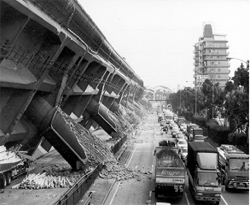UMR joins national ‘cybersystem’ for earthquake engineering research
Posted by news
University of Missouri-Rolla researchers will soon connect in cyberspace with investigators around the world to conduct and observe earthquake experiments.
The experiments exemplify the ambitious nature of the National Science Foundation’s two-phase, $500 million George Brown Jr. Network for Earthquake Engineering Simulation (NEES). With the completion of phase one in 2004, NEES established the first major research equipment in earthquake engineering by creating a shared national network of 15 experimental facilities, all linked by the ultra-high-speed Internet2. The new research facilities now allow researchers from a wide variety of disciplines to pool their experiences in dealing with earthquakes in the United States and beyond, and perform experiments and simulations on a larger scale than ever before.
NEES will also spend $150 million to support earthquake engineering research through 2014. UMR’s research project, a collaboration with four other universities, was one of the first to be funded by NEES in this second phase. The five-university team, led by Dr. David Sanders at the University of Nevada-Reno, will receive $1.42 million over the next four years to study the complex loading that can occur in bridge structures during earthquakes. The University Transportation Center at UMR is also supporting the UMR team’s work.
The research team will develop minimum design guidelines that will help future bridge engineers design safer bridges. In addition to UMR and UNR, the team includes the University of California-Los Angeles, the University of Illinois-Urbana Champaign and Washington University-St. Louis. The five-member team will eventually work directly with Japanese researchers to understand earthquake bridge design at a more international level.
“We are in an earthquake-prone area close to the New Madrid fault line, the most active fault east of the Rockies,” says team member Dr. D.J. Belarbi, Curators’ Teaching Professor of civil, architectural and environmental engineering at UMR. “One of the nation’s largest devastating earthquakes happened in this area in 1812. We know that the infrastructure in this area is prone to behave very badly if an earthquake hits.”
 |
When the columns that support the deck of bridges “are excited by an earthquake, they can undergo different types of loading — twisting, pushing, bending — all at the same time and in every direction,” explains Dr. Ashraf Ayoub, assistant professor of civil, architectural and environmental engineering at UMR.
“One of the main outcomes of the research will be to better understand the response of bridges under earthquakes,” says Dr. Pedro Silva, assistant professor of civil, architectural and environmental engineering at UMR. “There are some bridges that we know are not capable of withstanding an earthquake.”
The UMR team will focus its efforts on determining the proper design for bridge columns to survive a large earthquake that may result in complex loading. “The result of our research could definitely be used for future constructions or for helping the various departments of transportation and the Federal Highway Administration assess their existing bridges and develop strengthening-design protocols to avoid such disasters,” adds Belarbi.
UMR researchers will remotely test a prototype bridge at the NEES site at UIUC from their offices at UMR using the NEES cybersystem. In addition to the remote bridge test, the five-university team will examine single bridge columns at UMR and UIUC and test subsystems on shake tables at UNR.
“Washington University will package education, training and outreach activities for practicing engineers, teachers, and students in grades K-12,” Belarbi adds.
As part of the project, UMR established a node on the NEES-grid, called the Point of Presence system, which will allow others to observe UMR’s laboratory activities online from anywhere in the world. “Researchers will watch what we do in the lab and have access to all the information we get in our tests on real-time,” explains Belarbi. “With the node and this research project, UMR has again proved its commitment to joining and contributing to the larger earthquake research community.”
For more information about each university’s research effort, email the following:
- Dr. A. Belarbi, University of Missouri-Rolla, belarbi@mst.edu
- Dr. D. Sanders, University of Nevada-Reno, sanders@unr.edu
- Dr. A. Elnashai, University of Illinois-Urbana Champaign, aelnash@uiuc.edu
- Dr. J. Zhang, University of California-Los Angeles, zhangj@ucla.edu
- Dr. S. Dyke, Washington University-St. Louis, sdyke@seas.wustl.edu